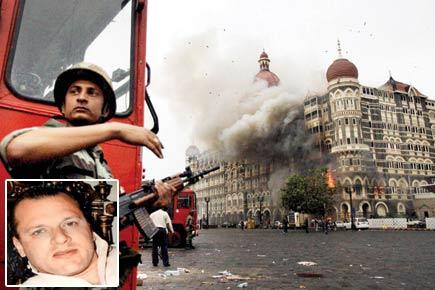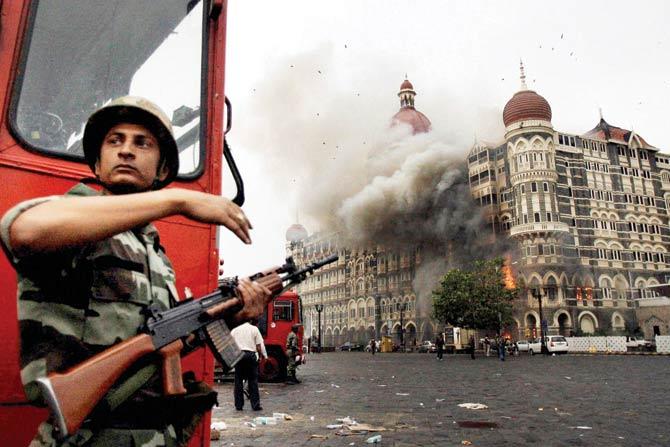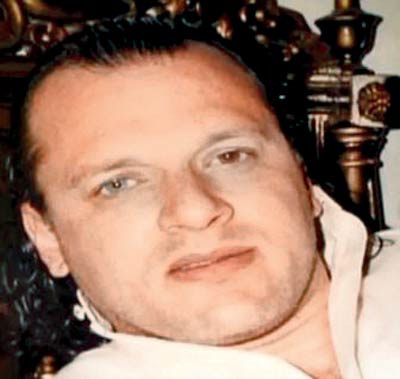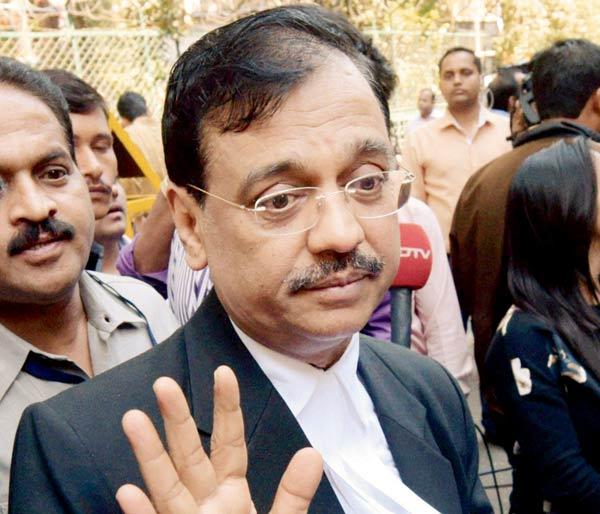On day one of the 26/11 attack trial proceedings, which lasted for almost five hours, David Coleman Headley, one of the prime accused, deposed before the TADA court via video-conferencing from the US and nailed Pakistan for its involvement in the 2008 attacks

26/11
The Special Terrorist And Disruptive Activities Prevention Act (TADA) Court yesterday recorded the statement of 26/11 attack prime accused, David Coleman Headley, who has been convicted by a US court for his role in the attack. The US court has awarded Headley a 35-year jail term. He has now become an approver in the case. Headley, in presence of his lawyer and the US Attorney, deposed before Special Judge G A Sanap via video-conferencing.
ADVERTISEMENT

Smoke is seen billowing out of the ground and first floor of the Taj Hotel during security personnel’s ‘Operation Cyclone’ following the 26/11 terror attacks in 2008
Even before the proceedings commenced, the courtroom was packed to its capacity by 7 am. Those present in the room included Special Public Prosecutor (SPP) Ujjwal Nikam, US embassy officials, National Investigation Agency officials from Mumbai and Delhi, officials from IB, Mumbai police, media persons.

LeT operative David Coleman Headley deposed before the TADA court yesterday from the US via video-conferencing
Two televisions were mounted inside the courtroom. While one streamed Headley’s deposition, the other one streamed Zabiuddin Ansari alias Abu Jundal live from Arthur Road Jail. Judge Sanap entered the courtroom at 7.10 am and initiated the proceedings by 7.15.

Special Public Prosecutor Ujjwal Nikam addressed media persons outside Tada Court. pics/Pti
The hearing commenced with Jundal stating that he no longer wanted to be defended by Memood Pracha and needed time to finalise a new lawyer, as he felt Pracha would ruin his case. Jundal also informed the court that he has filed an application before the Principal Judge seeking transfer of the case and requested the court to defer the hearing.
Taking objection to Jundal’s demand, Nikam said, "These are mere delaying tactics. Headley is here and we have made all the arrangements."
Meanwhile, Pracha’s assistant Ishrat Khan appeared in the court and said that he, along with senior counsel, would like to represent Jundal. Judge Sanap asked Khan to seek Jundal’s consent on the matter. Following a conversation between the two, Jundal agreed upon Khan defending him for the time being.
Headley’s Deposition
Following his introduction to the court, Headley was asked to stand up and take an oath that whatever he says before court is the truth, the whole truth and nothing but the truth. Dressed in a grey t-shirt and brown trousers, Headley answered every question posed to him without hesitation. The question-answer session lasted for almost five hours — from 7.30 am to 12.15 pm — during which two short recesses of 20 minutes each were taken.
Excerpts from Q&A
Nikam (N): You entered into a plea agreement with the US government in 2010. Is that right?
Headley (H): Yes
N: By the said agreement, you will truthfully testify before foreign judiciary via video-telephonic conference?
H: Yes
N: You also agree that if you do not agree, you will be entailed to death penalty for all the offences?
H: Yes
N: Is it that US court framed 12 charges in all and you pleaded guilty?
H: Yes
N: Your profile please?
H: I was born on June 30, 1960, in Washington DC, US. I am a citizen of US by birth. Immediately after my birth, my parents took me to Pakistan where I did my schooling at Habib public school in Karachi and then went to Hasan Abdal Cadet College in Punjab Province. It was an army type school for five years and later, at the age of 18, I shifted back to the US. I stayed there with my mother.
N: Which languages do you know?
H: English, Hindi and Urdu.
N: What was your name at birth?
H: Dawood Gilani.
N: Your father’s name?
H: Saleem Gilani
N: What is your present name?
H: David Coleman Headley.
N: When did you apply for change of name?
H: I applied in October 2005 and it was changed in Philadelphia on February 15, 2006.
N: Where did you decide to change your name?
H: In Pakistan.
PAK AND LeT LINKS
N: Why did you change your name?
H: To secure a passport in that name.
N: Why did you want a new passport?
H: So that I can enter India.
N: Why did you change the name when you could’ve entered using your original name?
H: So that I could conceal my real identity.
N: After changing the name, which country did you visit first?
H: Pakistan.
N: In Pakistan, to whom did you inform about the name change?
H: I disclosed it to my colleagues in LeT.
N: Who were your colleagues?
H: Sajid Mir. He was the person I was dealing with. Though I met several, he was my main contact.
N: Why did you inform Mir about the name change?
H: It was he who had asked me to change my name, so I informed him.
N: How did he react upon hearing your new name?
H: He was pleased and approved it.
N: When did you visit Pakistan after changing your name?
H: Immediately. Maybe a few weeks later.
N: May I know what was the task given for which you were asked to change your name?
H: I was assigned the task of visiting India and opening an office.
N: What was the intention behind setting up the office?
H: So that I could settle down.
N: Any specific reason?
H: Initially he didn’t mention anything, but later he did. Mir asked me to shoot a video of Mumbai.
N: Did you check the purpose with him?
H: I didn’t.
N: You didn’t ask because you were an LeT follower?
H: I was a true follower. I had a fair idea about it (as to why I was assigned to take a general video of Mumbai.)
N: Were you issued any US passport?
H: Yes. In the name of Sayyed Dawood Gilani
N: What happened of it?
H: I think, I returned it for a new one.
MUMBAI VISIT
N: How many times did you visit Mumbai before 26/11 terror attack?
H: Seven times.
N: How many times did you visit Mumbai after the attack?
H: Only once, on March 7, 2009.
N: Out of eight, seven times you came to Mumbai via Karachi?
H: It’s correct.
(Headley was shown two passports in which he identified his photos, signatures and contents. When he was asked about the passports, he said)
H: I submitted these documents in Chicago on June 30, 2006. Some of the contents of documents are incorrect. The contents, which are incorrect, were written by me.
N: What was the purpose behind submitting false info?
H: The purpose was to protect my identity while applying for visa.
N: What was the incorrect info?
H: Father’s name, Nationality of Father, Marital Status, Address, Phone number, Profession… ‘Pretty much everything’, except place and date of birth, mother’s nationality, my nationality and passport number. Rest everything is false.
(When he was shown his second visa, he identified his photo, signs and its contents.)
H: This time, I was obtaining visa for 5 years for Mumbai, which I got. Details mentioned in this application were same as above. Rana knew the purpose of me visiting India, so he helped me obtain one.
(Headley informed the court that his school friend Dr Tahbbur Rana helped secure a Business visa for multiple entries.)
N: Why a business visa?
H: So that I don’t have to apply again and again.
N: What cover story did you cook up?
H: I posed as an immigration consultant in Mumbai from the Immigration Law Centre, Chicago.
N: Who had given you this advice?
H: Sajid Mir, the same LeT operative.
TRANSFORMATION INTO A PAK SPY
Headley said he and his friend, retired Major Abdul Pasha, were to meet drug smuggler Zaid Shah in Federally Administered Tribal Areas (FATA) near Afghan border. Headley thought Shah would help them smuggle weapons to India. However, Headley was arrested because foreigners are not allowed in FATA and also for possessing literature on India. At
FATA, he was interrogated by Ali (an ISI man at Landi Kotal next to Afghan border). Besides Ali’s intervention, Headley Pakistani identity saved him. Later, Ali introduced Headley to Major Iqbal. "I was introduced to ISI Major Iqbal by Ali, as I wanted to go to India."
When Headley was asked why did Ali introduce him to Major Iqbal, he said, "Because he thought I could be useful for intelligence work in India." Headley identified Mir when he was shown his picture.
ATTACK ON MUMBAI
N: Has anyone from LeT ever mentioned about attack prior to 26/11?
H: Mir told me that two earlier attacks had failed.
N: When was the first attack attempted and why did it fail?
H: It was in September 2008. This attack failed because the boat hit against some rocks in the ocean and disintegrated. Those onboard swam to the safety of the shore using lifejackets.
N: Where did this boat start?
H: It probably started from Karachi.
N: What happened of the explosives and weapons on the boat?
H: All was lost in the ocean
N: When was second attempt made and why did it fail?
H: The second attempt was made in the same month or later. This also failed.
N: Who were there in that boat?
H: The same ten people as before.
N: Was LeT successful the third time?
H: Yes.
N: Was it the same 10 people?
H: Yes
HEADLEY’S INSPIRATION TO JOIN LeT
N: When did you join LeT?
H:My first course was in 2002 at Muzaffarabad, in ‘Azad Kashmir’.
N: Whose speech motivated you?
H: LeT chief, Hafiz Saeed Sab
(He identified Saeed after he was showed his photograph)
N: Is Lashkar a militant organisation from Pakistan?
H:Yes
N: What is its goal?
H: Fight the Indian army in Kashmir and assist Kashmiris.
N: Does LeT carry out terrorist activities across India?
H: Yes
TRAINING WITH HAFIZ SAEED AND LAKHVI
N: Are you aware of Dawrah-e-ama?
H: It is the preliminary military course. Dawrah-e-khasa is the advanced course. It is conducted in in Muzaffarbad, Pakistan. Recruits are trained in handling explosives and weapons. Dawrah-e-riba is an intelligence course.
N: What did you learn from these courses?
H: Setting up a safe house and conducting recce, which was done near Abbotabad. All these places are protected by LeT.
N: Did take any leadership course?
H: Yes. It was conducted near Abbotabad.
N: Who were its speakers?
H: Hafiz Saeed and Zakir-ur-Rehman Lakhvi alias Lakhvi.
N:What type of lectures did they deliver?
H: Mostly religious speeches.
N: Did they teach you about Jihad?
H: Yes
N: What does Jihad mean to you?
H: To fight against enemies of Islam.
N: Did you, Hafiz Saeed and Lakhvi consider India as an enemy?
H: Yes
N: Have you every fought against Indian troops in Kashmir?
H: No
N: Did you wanted to?
H: Yes
N: Then why didn’t you go there?
H: Because I was told that I was too old for Kashmir
N: Who said this you?
H: Lakhvi. He said that they’d use me for other things
N: Did Lakhvi mention this specific purpose?
H: In 2006, I was instructed by Mir. But I dot know whether Lakhvi had asked Mir to do so
N: You also mentioned about Muzammil?
H: Yes. His is a Lashkar person
N: Who else do you remember?
H: Abu Furka, Sana Ulla, Abu Hanzala, Abu Usman, Abu Saeed and Abu Fahad Ulla. I don’t remember Abu Suraya and Mukti Saeed.
N: Were all these retired officers from Pakistan Military?
H: No. None of them…maybe a few
N: Did they knew how to operate sophisticated weapons?
H: If AK-47 is sophisticated, then yes.
N: All these were real or nicknames?
H:They were all nicknames.
N: Did any of them ever disclose their real names to you?
H: None
 Subscribe today by clicking the link and stay updated with the latest news!" Click here!
Subscribe today by clicking the link and stay updated with the latest news!" Click here!






